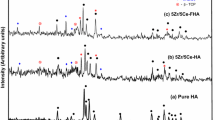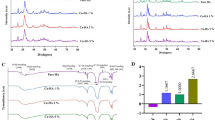Abstract
Fabrication of hydroxyapatite (HA) via doping with metal ions to enhance its antibacterial properties has attracted much interest. The present study aims to synthesize copper-silver doped hydroxyapatite particles (Cu-Ag doped HA) with an improved antibacterial activity through a sol-gel technique coupled with ultrasonic irradiation. The doping materials consist of Cu2+ and Ag+ ions with precursor molar ratios of 0.0, 0.25, 0.50, 0.75 and 1.0. The physicochemical properties of Ca9.0Cu1.0-xAgx(PO4)6(OH)2 samples were investigated using X-ray diffraction, Fourier-transform infrared spectroscopy (FT-IR), and transmission electron microscopy coupled with energy dispersive X-ray analysis (TEM-EDS). Characterization studies revealed that Cu2+ and Ag+ ions were incorporated into a hexagonal framework of HA. The main functional groups were identified as hydroxyl (OH−) and phosphate (PO43−) moieties. Their morphologies were rod-shaped with various diameters and particle size distributions, depending on the molar ratio of Cu2+ to Ag+. Antibacterial activity was evaluated using an agar well diffusion method against Staphylococcus epidermis, S. aureus, Bacillus subtilis, B. cereus, and Pseudomonas aeruginosa. It was found that Cu-Ag doped HA is an effective antibacterial agent. Ca9.0Cu0.5Ag0.5(PO4)6(OH)2 showed the best antibacterial performance against all bacterial strains with inhibition zones ranging from 13 to 17 mm, indicating its suitability as an antibacterial material in biomedical applications.

Highlights
-
1.
Ultrasonic treatment combined with a sol-gel technique synthesized well dispersed, rod-shaped Cu-Ag doped HA.
-
2.
Ca9.0Cu0.5Ag0.5(PO4)6(OH)2 has excellent antibacterial activity against Gram-positive and Gram-negative bacteria.
-
3.
Cu-Ag doped HA nanoparticle is an effective antibacterial material in biomedical applications.







Similar content being viewed by others
References
Tamai N, Myoui A, Tomita T et al. (2002) Novel hydroxyapatite ceramics with an interconnective porous structure exhibit superior osteoconduction in vivo. J Biomed Mater Res 59:110–117. https://doi.org/10.1002/jbm.1222
Hench LL (1998) Bioceramics. J Am Ceram Soc 81:1705–1728. https://doi.org/10.1111/j.1151-2916.1998.tb02540.x
Hayashi K, Mashima T, Uenoyama K (1999) The effect of hydroxyapatite coating on bony ingrowth into grooved titanium implants. Biomaterials 20:111–119. https://doi.org/10.1016/S0142-9612(98)00011-8
Li T-T, Ling L, Lin M-C et al. (2019) Effects of ultrasonic treatment and current density on the properties of hydroxyapatite coating via electrodeposition and its in vitro biomineralization behavior. Mater Sci Eng C 105:110062. https://doi.org/10.1016/j.msec.2019.110062
Kumar GS, Thamizhavel A, Yokogawa Y et al. (2012) Synthesis, characterization and in vitro studies of zinc and carbonate co-substituted nano-hydroxyapatite for biomedical applications. Mater Chem Phys 134:1127–1135. https://doi.org/10.1016/j.matchemphys.2012.04.005
Wong WY, Mohd Noor A-F (2016) Synthesis and sintering-wet carbonation of nano-sized carbonated hydroxyapatite. Procedia Chem 19:98–105. https://doi.org/10.1016/j.proche.2016.03.121
Ben-Arfa BAE, Miranda Salvado IM, Ferreira JMF, Pullar RC (2017) Novel route for rapid sol-gel synthesis of hydroxyapatite, avoiding ageing and using fast drying with a 50-fold to 200-fold reduction in process time. Mater Sci Eng C 70:796–804. https://doi.org/10.1016/j.msec.2016.09.054
Yelten-Yilmaz A, Yilmaz S (2018) Wet chemical precipitation synthesis of hydroxyapatite (HA) powders. Ceram Int 44:9703–9710. https://doi.org/10.1016/j.ceramint.2018.02.201
Sabu U, Logesh G, Rashad M, Joy A, Balasubramanian M (2019) Microwave assisted synthesis of biomorphic hydroxyapatiette. Ceram Int 45:6718–6722. https://doi.org/10.1016/j.ceramint.2018.12.161
Nosrati H, Mamoory RS, Svend Le DQ et al. (2020) Gas injection approach for synthesis of hydroxyapatite nanorods via hydrothermal method. Mater Charact 159:110071. https://doi.org/10.1016/j.matchar.2019.110071
Fihri A, Len C, Varma RS, Solhy A (2017) Hydroxyapatite: A review of syntheses, structure and applications in heterogeneous catalysis. Coord Chem Rev 347:48–76. https://doi.org/10.1016/j.ccr.2017.06.009
Balani K, Chen Y, Harimkar SP et al. (2007) Tribological behavior of plasma-sprayed carbon nanotube-reinforced hydroxyapatite coating in physiological solution. Acta Biomater 3:944–951. https://doi.org/10.1016/j.actbio.2007.06.001
Ramires PA, Romito A, Cosentino F, Milella E (2001) The influence of titania/hydroxyapatite composite coatings on in vitro osteoblasts behaviour. Biomaterials 22:1467–1474. https://doi.org/10.1016/S0142-9612(00)00269-6
Neira IS, Kolen’ko YV, Lebedev OI et al. (2009) An effective morphology control of hydroxyapatite crystals via hydrothermal synthesis. Cryst Growth Des 9:466–474. https://doi.org/10.1021/cg800738a
Kim H-W, Kong Y-M, Bae C-J et al. (2004) Sol–gel derived fluor-hydroxyapatite biocoatings on zirconia substrate. Biomaterials 25:2919–2926. https://doi.org/10.1016/j.biomaterials.2003.09.074
Kaur S, Bala N, Khosla C (2013) Preparation and deposition of hydroxyapatite on biomaterials by sol-gel technique-a review. Chitkara Chemistry Review 1:59–69. https://doi.org/10.15415/ccr.2013.12011
Liu DM, Troczynski T, Tseng WJ (2002) Aging effect on the phase evolution of water-based sol–gel hydroxyapatite. Biomaterials 23:1227–1236. https://doi.org/10.1016/s0142-9612(01)00242-3
Yan Q, Qiu M, Chen X, Fan Y (2019) Ultrasound assisted synthesis of size-controlled aqueous colloids for the fabrication of nanoporous zirconia membrane. Front Chem 7:1–10. https://doi.org/10.3389/fchem.2019.00337
Phatai P, Futalan CM, Utara S et al. (2018) Structural characterization of cerium-doped hydroxyapatite nanoparticles synthesized by an ultrasonic-assisted sol-gel technique. Results Phys 10:956–963. https://doi.org/10.1016/j.rinp.2018.08.012
Lamkhao S, Phaya M, Jansakun C et al. (2019) Synthesis of hydroxyapatite with antibacterial Properties Using a microwave-assisted combustion method. Sci Rep 9:1–9. https://doi.org/10.1038/s41598-019-40488-8
Phatai P, Futalan CM, Kamonwannasit S, Khemthong P (2019) Structural characterization and antibacterial activity of hydroxyapatite synthesized via sol-gel method using glutinous rice as a template. J Sol-Gel Sci Technol 89:764–775. https://doi.org/10.1007/s10971-018-4910-9
Utara S, Klinkaewnarong J (2015) Sonochemical synthesis of nano-hydroxyapatite using natural rubber latex as a templating agent. Ceram Int 41:14860–14867. https://doi.org/10.1016/j.ceramint.2015.08.018
Utara S, Klinkaewnarong J (2015) Effect of sonication time on the characteristics of nanophase hydroxyapatite crystals synthesised by the sol–gel technique. Micro Nano Lett 10:1–4. https://doi.org/10.1049/mnl.2014.031620
Kim W, Saito F (2001) Sonochemical synthesis of hydroxyapatite from H3PO4 solution with Ca(OH)2. Ultrason Sonochem 8:85–88. https://doi.org/10.1016/s1350-4177(00)00034-1
Rouhani P, Taghavinia N, Rouhani S (2010) Rapid growth of hydroxyapatite nanoparticles using ultrasonic irradiation. Ultrason Sonochem 17:853–856. https://doi.org/10.1016/j.ultsonch.2010.01.010
Sadat-Shojai M, Khorasani M-T, Dinpanah-Khoshdargi E, Jamshidi A (2013) Synthesis methods for nanosized hydroxyapatite with diverse structures. Acta Biomater 9:7591–7621. https://doi.org/10.1016/j.actbio.2013.04.012
Gopi D, Govindaraju KM, Victor CAP et al. (2008) Spectroscopic investigations of nanohydroxyapatite powders synthesized by conventional and ultrasonic coupled sol–gel routes. Spectrochim Acta A Mol Biomol Spectrosc 70:1243–1245. https://doi.org/10.1016/j.saa.2008.02.015
Fakharzadeh A, Ebrahimi-Kahrizsangi R, Nasiri-Tabrizi B, Jefrey Basirun W (2017) Effect of dopant loading on the structural features of silver-doped hydroxyapatite obtained by mechanochemical method. Ceram Int 43:12588–12598. https://doi.org/10.1016/j.ceramint.2017.06.136
Iqbal N, Abdul Kadir MR, Nik Malek NAN et al. (2013) Characterization and antibacterial properties of stable silver substituted hydroxyapatite nanoparticles synthesized through surfactant assisted microwave process. Mater Res Bull 48:3172–3177. https://doi.org/10.1016/j.materresbull.2013.04.068
Hedrick TL, Adams JD, Sawyer RG (2006) Implant-associated infections: an overview. J Long Term Eff Med 16:83–99. https://doi.org/10.1615/jlongtermeffmedimplants.v16.i1.90
Shanmugam S, Gopal B (2014) Copper substituted hydroxyapatite and fluorapatite: Synthesis, characterization and antimicrobial properties. Ceram Int 40:15655–15662. https://doi.org/10.1016/j.ceramint.2014.07.086
Batebi K, Abbasi Khazaei B, Afshar A (2018) Characterization of sol-gel derived silver/fluor-hydroxyapatite composite coatings on titanium substrate. Surf Coat Technol 352:522–528. https://doi.org/10.1016/j.surfcoat.2018.08.021
Rameshbabu N, Sampath Kumar TS, Prabhakar TG et al. (2007) Antibacterial nanosized silver substituted hydroxyapatite: synthesis and characterization. J Biomed Mater Res A 80:581–591. https://doi.org/10.1002/jbm.a.30958
Gristina AG (1987) Biomaterial-centered infection: microbial adhesion versus tissue integration. Science 237:1588–1595. https://doi.org/10.1126/science.3629258
Kazachenko AS, Legler AV, Per’yanova OV, Vstavskaya YuA (2000) Synthesis and antimicrobial activity of silver complexes with histidine and tryptophan. Pharm Chem J 34:257–258. https://doi.org/10.1007/BF02524634
Rai M, Yadav A, Gade A (2009) Silver nanoparticles as a new generation of antimicrobials. Biotechnol Adv 27:76–83. https://doi.org/10.1016/j.biotechadv.2008.09.002
Hidalgo E, Domínguez C (1998) Study of cytotoxicity mechanisms of silver nitrate in human dermal fibroblasts. Toxicol Lett 98:169–179. https://doi.org/10.1016/s0378-4274(98)00114-3
Gopi D, Shinyjoy E, Kavitha L (2014) Synthesis and spectral characterization of silver/magnesium co-substituted hydroxyapatite for biomedical applications. Spectrochim Acta A Mol Biomol Spectrosc 127:286–291. https://doi.org/10.1016/j.saa.2014.02.057
Ghosh R, Swart O, Westgate S et al. (2019) Antibacterial copper–hydroxyapatite composite coatings via electrochemical synthesis. Langmuir 35:5957–5966. https://doi.org/10.1021/acs.langmuir.9b00919
Unabia RB, Bonebeau S, Candidato RT, Pawłowski L (2018) Preliminary study on copper-doped hydroxyapatite coatings obtained using solution precursor plasma spray process. Surf Coat Technol 353:370–377. https://doi.org/10.1016/j.surfcoat.2018.09.008
Kim TN, Feng QL, Kim JO et al. (1998) Antimicrobial effects of metal ions (Ag+, Cu2+, Zn2+) in hydroxyapatite. J Mater Sci Mater Med 9:129–134. https://doi.org/10.1023/A:1008811501734
Turkoz M, Atilla AO, Evis Z (2013) Silver and fluoride doped hydroxyapatites: Investigation by microstructure, mechanical and antibacterial properties. Ceram Int 39:8925–8931. https://doi.org/10.1016/j.ceramint.2013.04.088
Landi E, Sprio S, Sandri M et al. (2008) Development of Sr and CO3 co-substituted hydroxyapatites for biomedical applications. Acta Biomater 4:656–663. https://doi.org/10.1016/j.actbio.2007.10.010
Sen A, Batra AA (2012) Evaluation of antimicrobial activity of different solvent extracts of medicinal plant: Melia Azedarach L. Int J Curr Pharm Res 4:67–73
Kamonwannasit S, Nantapong N, Kumkrai P et al. (2013) Antibacterial activity of Aquilaria crassna leaf extract against Staphylococcus epidermidis by disruption of cell wall. Ann Clin Microbiol Antimicrob 12:20. https://doi.org/10.1186/1476-0711-12-20
Guo X, Yan H, Zhao S et al. (2013) Effect of calcining temperature on particle size of hydroxyapatite synthesized by solid-state reaction at room temperature. Adv Powder Technol 24:1034–1038. https://doi.org/10.1016/j.apt.2013.03.002
Sompech S, Dasri T, Thaomola S (2016) Preparation and characterization of amorphous silica and calcium oxide from agricultural wastes. Orient J Chem 32:1923–1928. https://doi.org/10.13005/ojc/320418
Hayakawa S, Hajima Y, Qiao S et al. (2008) Characterization of calcium carbonate polymorphs with Ca K edge X-ray absorption fine structure spectroscopy. Anal Sci 24:835–837. https://doi.org/10.2116/analsci.24.835
Daculsi G, Laboux O, Malard O, Weiss P (2003) Current state of the art of biphasic calcium phosphate bioceramics. J Mater Sci Mater Med 14:195–200. https://doi.org/10.1023/A:1022842404495
Labanni A, Zulhadjri, Handayani D, Ohya Y, Arief S (2020) Size controlled synthesis of well-distributed nano-silver on hydroxyapatite using alkanolamine compounds. Ceram Int 46:5850–5855. https://doi.org/10.1016/j.ceramint.2019.11.035
Grigoraviciute-Puroniene I, Stankeviciute Z, Ishikawa K, Kareiva A (2020) Formation of calcium hydroxyapatite with high concentration of homogeneously distributed silver. Micropor Mesopor Mat 293:xxx. https://doi.org/10.1016/j.micromeso.2019.109806
Zhang P, Lu H, Zhou Y, et al (2015) Mesoporous MnCeOx solid solutions for low temperature and selective oxidation of hydrocarbons. Nat Commun 6. 10.1038/ncomms9446
Chen C-W, Oakes CS, Byrappa K et al. (2004) Synthesis, characterization, and dispersion properties of hydroxyapatite prepared by mechanochemical–hydrothermal methods. J Mater Chem 14:2425–2432. https://doi.org/10.1039/B315095J
Monshi A, Foroughi MR, Monshi MR (2012) Modified Scherrer equation to estimate more accurately nano-crystallite size using XRD. World J Nano Sci Eng 2:154–160. https://doi.org/10.4236/wjnse.2012.23020
Türk S, Altınsoy İ, ÇelebiEfe G et al. (2017) Microwave–assisted biomimetic synthesis of hydroxyapatite using different sources of calcium. Mater Sci Eng C 76:528–535. https://doi.org/10.1016/j.msec.2017.03.116
Cheng ZH, Yasukawa A, Kandori K, Ishikawa T (1998) FTIR Study of Adsorption of CO2 on Nonstoichiometric Calcium Hydroxyapatite. Langmuir 14:6681–6686. https://doi.org/10.1021/la980339n
Waheed S, Sultan M, Jamil T, Hussain T (2015) Comparative analysis of hydroxyapatite synthesized by sol-gel, ultrasonication and microwave assisted technique. Mater Today Proc 2:5477–5484. https://doi.org/10.1016/j.matpr.2015.11.073
Gopi D, Bhuvaneshwari N, Indira J et al. (2013) A novel green template assisted synthesis of hydroxyapatite nanorods and their spectral characterization. Spectrochim Acta A Mol Biomol Spectrosc 107:196–202. https://doi.org/10.1016/j.saa.2013.01.052
Jadalannagari S, Deshmukh K, Ramanan SR, Kowshik M (2014) Antimicrobial activity of hemocompatible silver doped hydroxyapatite nanoparticles synthesized by modified sol–gel technique. Appl Nanosci 4:133–141. https://doi.org/10.1007/s13204-013-0197-x
Nath S, Kalmodia S, Basu B (2010) Densification, phase stability and in vitro biocompatibility property of hydroxyapatite-10 wt% silver composites. J Mater Sci Mater Med 21:1273–1287. https://doi.org/10.1007/s10856-009-3939-2
Rajendran A, Barik RC, Natarajan D et al. (2014) Synthesis, phase stability of hydroxyapatite–silver composite with antimicrobial activity and cytocompatability. Ceram Int 40:10831–10838. https://doi.org/10.1016/j.ceramint.2014.03.075
Buckley JJ, Lee AF, Olivi L, Wilson K (2010) Hydroxyapatite supported antibacterial Ag3PO4 nanoparticles. J Mater Chem 20:8056–8063. https://doi.org/10.1039/c0jm01500h
Acknowledgements
We would like to acknowledge the Department of Chemistry (Faculty of Science) and the Research and Development Institute of the Udon Thani Rajabhat University (Thailand) for their financial support of this research undertaking. Many thanks to Professor Dr. Jeffrey C. Nash from the Office of Graduate Studies of the Udon Thani Rajabhat University (Thailand) for his assistance in proofreading this manuscript.
Author information
Authors and Affiliations
Corresponding author
Ethics declarations
Conflict of interest
The authors declare that they have no conflict of interest.
Additional information
Publisher’s note Springer Nature remains neutral with regard to jurisdictional claims in published maps and institutional affiliations.
Supplementary information
Rights and permissions
About this article
Cite this article
Kamonwannasit, S., Futalan, C.M., Khemthong, P. et al. Synthesis of copper-silver doped hydroxyapatite via ultrasonic coupled sol-gel techniques: structural and antibacterial studies. J Sol-Gel Sci Technol 96, 452–463 (2020). https://doi.org/10.1007/s10971-020-05407-8
Received:
Accepted:
Published:
Issue Date:
DOI: https://doi.org/10.1007/s10971-020-05407-8




